Airfix 1/72 Ford 5-AT Trimotor
|
KIT #: |
4009 |
|
PRICE: |
$8.00 when new |
|
DECALS: |
Two options |
|
REVIEWER: |
Carmel J. Attard |
|
NOTES: |
|
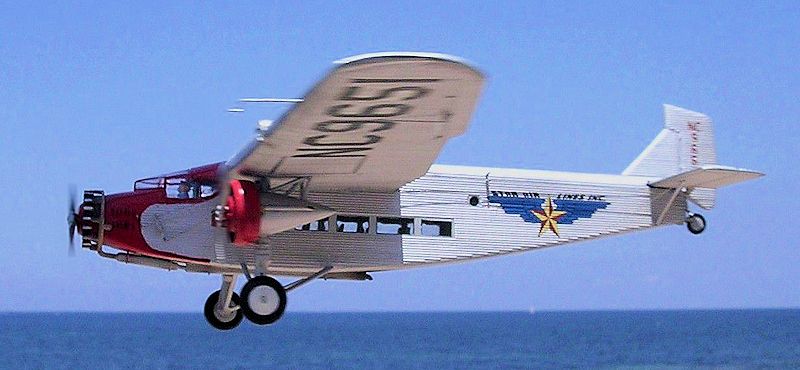
The Ford
Tri-Motor was one of the outstanding civil aircraft of all time and a few of
these machines are still in service. It was responsible for the growth of
airline system in the USA, and achieved a record of reliability unsurpassed
until the advent of the DC-3.
In
1925 Henry Ford purchased the Stout Metal Airplane Company, and a year later
produced the 4-AT, the first of 200 Tri-Motors produced during the next seven
years of on assembly lines similar to those Ford
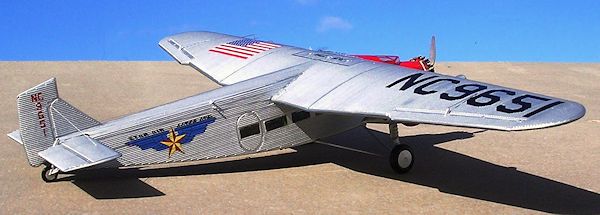 used to
produce cars. From 1926 until June 1929 the 4-AT was in production and in
service with many airlines, opening up new routes across North America and
laying the foundations for the present airways systems; many were used as
executive aircraft and as transport by the military services.
used to
produce cars. From 1926 until June 1929 the 4-AT was in production and in
service with many airlines, opening up new routes across North America and
laying the foundations for the present airways systems; many were used as
executive aircraft and as transport by the military services.
In 1928
the Ford AT-5 was introduced, this having more powerful engines and larger
airframe to give increased seating capacity. The 5-AT-B had seating for 15 and
the 5-AT-C for 17. 116 if this new version were delivered before production
ceased in 1933, by which time more modern airliners such as the Boeing 247 and
Douglas DC-2 were about to enter service.
From 1934
until the 1960s many were used on regular passenger, freight and mail service in
remote and unprepared regions, and the service was then modified to carry heavy
machinery and fuel to mining areas. A few are still in use on passenger
sight–seeing trips in the USA. The 5-AT Tri-Motor is powered by three 420 hp
Pratt Whitney Wasp 7-cylinder radial engines, giving it a maximum speed of 153
mph and a range of 510 miles. The Tri-Motor had a wingspan of 77’10”, Length of
49’ 10” and a height of 13’6”.
This is a Special Edition re-issue
under the box heading Classic Airliners as a series 4 models. Interesting about
this issue is that it carried a popular American Airways of the pre war 1933 era
that fa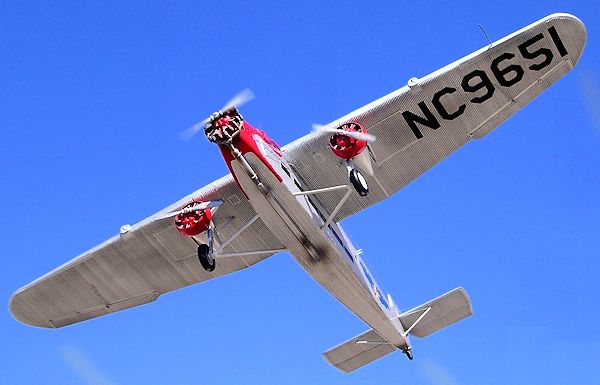 lls
in the category of US Mail aircraft.
Markings are also provided for an overall metal finish
Ford JR-3 that served with the US. Marine Corps circa July 1930 with pre-war
style US insignia and markings.
lls
in the category of US Mail aircraft.
Markings are also provided for an overall metal finish
Ford JR-3 that served with the US. Marine Corps circa July 1930 with pre-war
style US insignia and markings.
The kit
is injection molded in silver plastic and contains 86 parts that include the
fuselage side windows and cockpit canopy in clear plastic. There is provision
for a complete cockpit office including crew figures in typical costume of the
era, and also main passenger compartment with floor, seating for 12, bulkheads
that separate the cockpit from passenger area and aft bulkhead. A fuselage door
can be fixed in open or closed form. The
engines are well detailed and the overall look of the model is quite pleasing.
The wings have fine corrugated surface detail.
This
kit was built in accordance to the Airfix instruction sheet with a difference
that it was completed in the livery of Star Airlines Inc. This entails some
extra work on the model since it is built as a Tri-motor 2 version with
registration NC9651.
 The
extra work on the kit consists of the following: Extending the exhaust pipe at
the side of engines; modifying the exhaust manifold fixed under the fuselage by
inserting a thicker intermediate pipe with rounded ends. This was made from
sprue of correct thickness; added pipe retaining brackets made from bent copper
wire; added another pipe intersection at port side of nose; removed wheel
mudguards, added control links to ailerons and elevators and tail wheel
supports; replaced wing leading edge pitot tube with one made of thinner
section. Finally the three two-blade propellers, which are supplied with pitch
backwards, were corrected by flipping the props round and add new shaft at
pressure side of prop.
The
extra work on the kit consists of the following: Extending the exhaust pipe at
the side of engines; modifying the exhaust manifold fixed under the fuselage by
inserting a thicker intermediate pipe with rounded ends. This was made from
sprue of correct thickness; added pipe retaining brackets made from bent copper
wire; added another pipe intersection at port side of nose; removed wheel
mudguards, added control links to ailerons and elevators and tail wheel
supports; replaced wing leading edge pitot tube with one made of thinner
section. Finally the three two-blade propellers, which are supplied with pitch
backwards, were corrected by flipping the props round and add new shaft at
pressure side of prop.
The kit
is completed in the livery of Star Air Lines. This interesting colour marking
comes with the 1/72-decal sheet from the range of Draw Decal sets 72-Trimotor-2
where the Airfix kit is recommended to be used. As operated in the Alaska
Territories of 1942, the aircraft is in natural metal. The forward fuselage
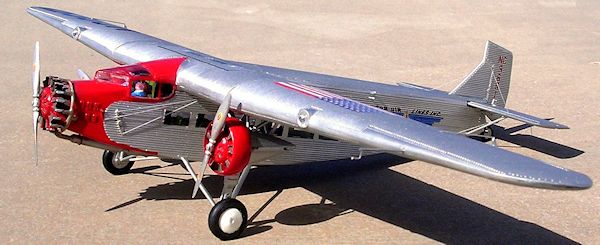 and
engine fronts and cowlings gloss red. The kit was airbrushed in silver overall
finish and red forward fuselage and other trimmings using standard Model Master
paint.
and
engine fronts and cowlings gloss red. The kit was airbrushed in silver overall
finish and red forward fuselage and other trimmings using standard Model Master
paint.
Draw Decal instructions also carried some
interesting information on the history of the Airline. Alaska Airline grew out
of a single-plane company established by Louis McGee in 1932. McGee Airlines
merged with Star Air Service in 1934. Under the leadership of Raymond W.Marshall,
the airline aggressively pursued further purchases to create Alaska Star
Airlines in 1942. The middle name was formally dropped on May 2, 1944 narrowly
beating out a competitor who also applied for the name Alaska Airlines.
The decal sheet instructions also indicated
that due to the corrugated surface of the Ford Tri-Motor the decal had to be
printed a bit differently from other reg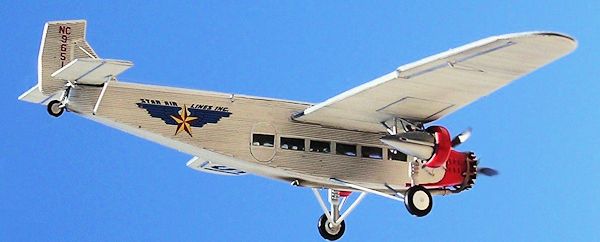 ular
line in the range. The Star logos were printed on Alps printer, therefore very
thin and will easily scratch. Care when handling and applying was therefore
needed. The remaining decals are
also thin and de-bond from paper if bent. It was suggested to apply a very thin
coat of Future prior to cutting and applying the decals. For this reason the
best results were achieved over the corrugated surface of the Tri-Motor.
The kit
was given an overall coat of Klear/Future.
ular
line in the range. The Star logos were printed on Alps printer, therefore very
thin and will easily scratch. Care when handling and applying was therefore
needed. The remaining decals are
also thin and de-bond from paper if bent. It was suggested to apply a very thin
coat of Future prior to cutting and applying the decals. For this reason the
best results were achieved over the corrugated surface of the Tri-Motor.
The kit
was given an overall coat of Klear/Future.
In the
end exhaust and oxidised surface around exhaust area was applied using a mix of
MM clear varnish and engine grey.
Not a
complicated detailing of a model but no rush was exercised in moving forward
with this kit, a little at a time, and best results were achieved. This was
another kit that falls in the category of ‘between the wars/Wings of peace’ era
of aviation.
Carmel
J. Attard
July 2013
If you would like your product reviewed fairly and fairly quickly, please
contact
the editor
or see other details in the
Note to
Contributors.
Back to the Main Page
Back to the Review
Index Page


 used to
produce cars. From 1926 until June 1929 the 4-AT was in production and in
service with many airlines, opening up new routes across North America and
laying the foundations for the present airways systems; many were used as
executive aircraft and as transport by the military services.
used to
produce cars. From 1926 until June 1929 the 4-AT was in production and in
service with many airlines, opening up new routes across North America and
laying the foundations for the present airways systems; many were used as
executive aircraft and as transport by the military services.  lls
in the category of US Mail aircraft.
Markings are also provided for an overall metal finish
Ford JR-3 that served with the US. Marine Corps circa July 1930 with pre-war
style US insignia and markings.
lls
in the category of US Mail aircraft.
Markings are also provided for an overall metal finish
Ford JR-3 that served with the US. Marine Corps circa July 1930 with pre-war
style US insignia and markings.

